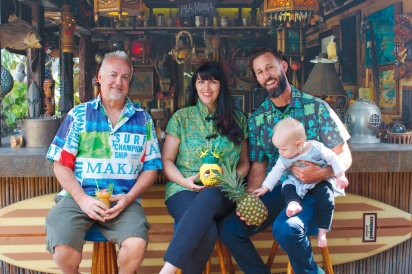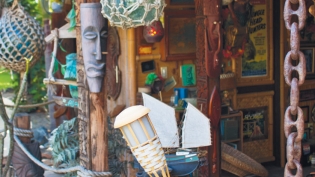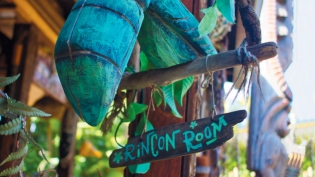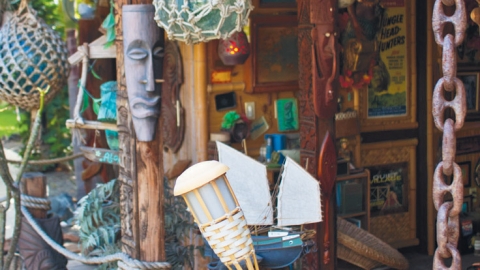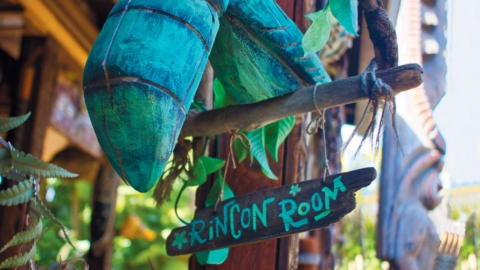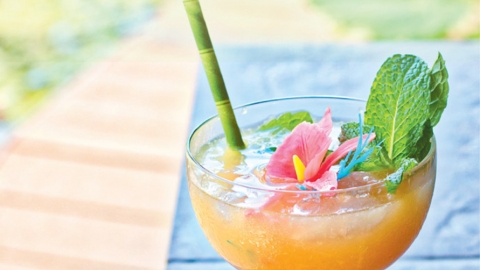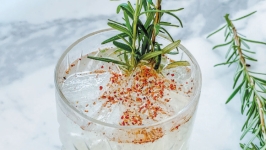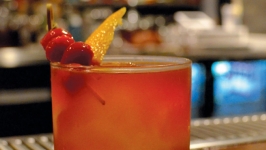Tiki Culture: Finding Aloha in Camarillo
Tiki culture in the United States dates back to 1934, with the opening of the bar Don the Beachcomber in Hollywood. Inspired by a journey to the Caribbean and South Pacific and a desire to replicate the tropical vibes of his travels, Texas-born Ernest Raymond Beaumont Gantt, or “Donn Beach,” opened the mainland’s first tiki bar. The iconic tropical Mai-tai—which Beach may or may not have invented, depending on whom you ask—and Zombie cocktails soon followed.
By the 1960s, the tiki trend was sweeping the nation, and folks were finding all sorts of ways to escape to the laid-back, rum-soaked world of aloha—from basement bars to tiny cocktail umbrellas jauntily garnishing drinks. Ventura County, too, began to develop its own history rich with tiki.
“There was Wellman Jue’s Paradise in Ventura, which had a tiki on their match cover, and the huge A-frame Trade Winds in Oxnard that had dozens of tikis,” Ron Ferrell tells us. “The Beach Boys and Arthur Lyman played there.” The Trade Winds quickly became the “hot place in town” when local developer Martin “Bud” Smith built it in 1964, according to Critiki.com.
Today, the tiki lifestyle can be found unexpectedly at the end of a cul-de-sac in Camarillo, where secretly lies one of the most photographed and sought-after backyard tiki destinations in the country: The Rincon Room.
We arrive at The Rincon Room on a Friday afternoon jangled after battling traffic, our nerves eased as soon as we step foot onto the property owned by Ron and his wife, Mickee. Koi fish swim at our feet, the smell of mint permeates the air, palm trees and hibiscus flowers surround us.
Different from the outdoor tiki bar made for summertime libations with friends, what Ron and Mickee have created is an entire tiki backyard and lifestyle—a space that has been nurtured by its caring gardeners to become the embodiment of living aloha. Which, at the core, means to live joyfully with love and nature and to treat all things with compassion and understanding. While a tiki vibe may be considered the physical representation of a space, an aloha vibe is one’s emotional connection to the space and, on a larger scale, to existence as a whole.
The Rincon Room is featured in the 2017 James Beard Foundation Award–winning Smuggler’s Cove: Exotic Cocktails, Rum and the Cult of Tiki (Ten Speed Press, 2016) by Martin Cate with Rebecca Cate. It was also featured in Tiki Magazine.
Ron and Mickee started turning their Camarillo home into a tiki paradise 12 years ago, inspired by their passion for tropical destination travel. First, it was rattan furniture and Hawaiian antiques for their den. Next it was tiki objects, vintage surf and Hawaiiana. Now collectibles and mid-century modern art cover nearly every inch of their home from the inside out. Parts of their collection have been featured in books and at a museum in Paris.
Ron recently presented a symposium on Polynesian black velvet paintings at The Hukilau, billed as the “World’s Most Authentic Tiki Event,” in Florida.
“We wanted to have a space that we could go to after work and feel like we are on vacation,” Ron says, offering us a Drifter’s Reef, a drink he created that you can find at his favorite local tiki hangout, Ventiki Tiki Lounge and Lanai in Ventura. (See recipe on the next page.)
“Aloha!” says a smiling Tiki Tony Murphy, an artist and designer famous in the tiki world, as he enters the backyard. Tony and Ron met on the website Tiki Central in 2002, two of the few people in the area interested in tiki culture at the time.
Tony grew up in Camarillo and now lives two miles from Ron. Both have backyards that abound with tropical flowers and plants, including palm trees. They also have gardens, whose bounty is used in the cocktails they create and for cooking. Gardening is an important part of the aloha spirit as it encourages sustainable living and creates a balance with nature through love, honor and respect.
In the yard he tends with his wife, Alene, for example, Tony can pick passionfruit, lemon verbena, spearmint, Black Mission figs and Honey Mandarin oranges. He even has a variety of banana trees, like the Musa “ice cream” banana, some of which were purchased from Green Thumb Nursery in Ventura.
Tony got his tiki start in college, when days spent as a kids’ surf instructor turned to afternoons spent collecting natural tidbits and driftwood found on C Street (aka California Street), just outside the fairgrounds in Ventura. He repurposed the found materials by carving them into tiki necklaces with a pocketknife and handing them out to his surf students.
He turned his hobby and art degree from Cal Poly San Luis Obispo into his profession, and now runs a business with Alene. Together they make and sell tiki mugs, everything from mermaids to puffer fish to toucans, parrots and monkeys. They weave pieces of inspiration into their artwork from the tropical landscape that Ventura County offers.
In the works is a submarine mug that Tony and Danny Gallardo (aka Tiki Diablo) are constructing; Ron will be developing a Torpedo Juice cocktail to fill it. They’re also working alongside Tiki Farm, a San Clemente–based manufacturer of tiki collectibles, to produce a toucan mug for Ventiki that is expected to be available in the fall.
“What’s your lasting piece of tiki wisdom?” we ask Tony as we head out.
“Tiki is all about escapism and aloha,” he says, sitting at the bar with a tropical cocktail in hand, watching his year-old daughter, Violet, reach towards the treasures that decorate The Rincon Room. “It’s like finding a fantasy tiki hut in the most perfect, exotic beach.”
Luckily, in Ventura County we have our own version of perfect beach and you, too, can create an aloha tiki vibe.



